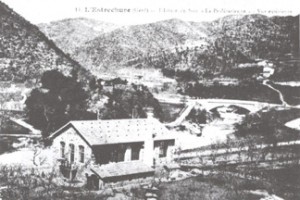The Cevennes: Silk Country
 In the 13th century throughout Languedoc and particularly in the Cévennes, nearly every family « educated » silk worms (a bizarre word used to explain silk worm rearing in the Cévennes) and prepared the silk thread.
In the 13th century throughout Languedoc and particularly in the Cévennes, nearly every family « educated » silk worms (a bizarre word used to explain silk worm rearing in the Cévennes) and prepared the silk thread.
The raw silk was then sold to traders. The weaving of the silk was carried out in the towns further south in the plains.
Silk stockings from the Cévennes were even sent to dress the calves in the Royal Courts of Europe! The prosperity of silk production was at its height in the first half of the 19th century. Then the small silk mills and workshops were gradually replaced by more productive industrial units.
At the limits of the Cévennes, at Ganges, Le Vigan, at Anduze and even at Saint Jean du Gard, the preparation of silk thread played a more important role than silk farming.
The development of steampower opened the door to the industrialisation of silk transformation and weaving. Each day, hundreds of workers, in particular working women and children, streamed into the Cevenol towns and villages to work in the silk mills.
Women made up the majority in many silk mills as they had been since the beginning of the adventure in the raising of silk cocoons. Great care was taken and prayers prayed that the egg would hatch and eventually become a cocoon.
La Filature Today
La Filature « The People’s Silk Mill » that we bought in June 2015, was founded in January 1910 as a villagers’ silk co-operative. It was inaugurated in the form of a Public Limited Company where the Board of Directors was elected. Shares worth 100 francs were issued, which people could acquire by either buying shares directly or by working in the construction of the mill.
At the same time, a fraternal benefit society was founded, embodying the modernity and the social importance of this innovative company.
La Filature used to provide silk for the Silk Company of Indo-China to where it was sent to make silk material. Activity diminished progressively, in particular around 1925 and 1942 and there were times when the entire silk worm production was devastated by a disease – « La Pebrine ». The opening of the Suez Canal, favourising the arrival of Chinese and Japanese silks, followed by competition by the development of rayon accelerated the decline of silk farming in the Cévennes.
By 1950 the Filature employed only about 40 workers and closed definitively in 1955.
From then on, local silk farming and manufacture regrouped around the Maison Rouge (Red House) in Saint Jean du Gard which was closed in January 1965, being the last French silk mill in activity.
La Filature building was then entirely remodelled and divided into separate apartments. The great bay windows were reduced in size and replaced with simple windows. An extra floor was added into the massive roofspace by dividing the workshop horizontally. The property nowadays sits at the exit of the village on the borders of Saumane.
